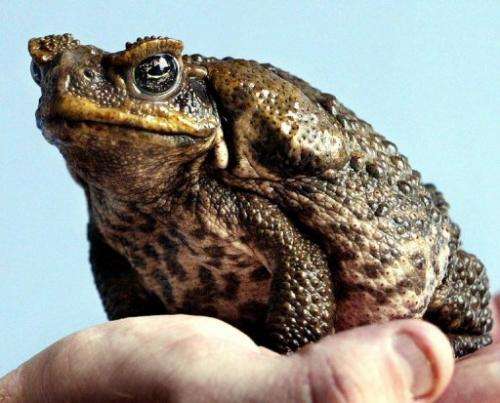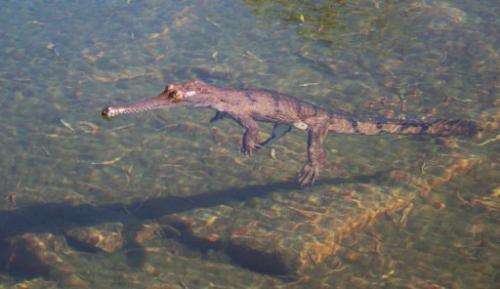Cane toads 'wiping out' mini crocodiles Down Under

Australia's noxious cane toad is wiping out populations of a unique miniature crocodile, researchers warned Wednesday, with fears the warty, toxic creature could extinguish the rare reptile.
A team from Charles Darwin University studying the impacts of the foul toad in upstream escarpments found "significant declines" in numbers of dwarf freshwater crocodiles after the amphibians' arrival.
Dwarf crocodiles are thought to be stunted due to a lack of available food and researchers believe the crocs started gobbling up the cane toads when they came along.
Lead researcher Adam Britton said there had been 28 of the rare crocs across the study area, around the Victoria and Bullo rivers in the Northern Territory, prior to the arrival of the toads.
The population declined to ten after the toads arrived, the study, conducted from 2007-2008 and published in the latest edition of the journal Wildlife Research, showed.
"Dead crocodiles and evidence of their having eaten cane toads strongly suggest that these declines were caused directly by the arrival of cane toads into the area," the study found.
Dwarf crocodiles, also known as pygmy or "stunted" crocodiles, grow to a maximum of 1.7 metres (five foot six inches), or 0.7 metres (two foot three inches) for females, half the size of other freshwater crocs.

There is no evidence that the rare pygmy is genetically different to other freshwater crocodiles.
Britton said there was concern that, due to their limited numbers—believed to be in the low hundreds—the pygmy croc could die out altogether due to the cane toad's march.
"We already know that cane toads kill freshwater crocodiles, but we were concerned that cane toads might have a major impact on dwarf populations because of their small size and lack of alternative food sources," Britton said.
"These are low-density populations to begin with," he continued. "They disappeared totally from one study site."
The researcher added: "We still have a long way to go in our understanding of how native populations deal with invasive species."
The study did offer some hope for the crocodiles, with no apparent population change recorded at one site and evidence of behavioural adaptations to avoid the poison by only eating the toad's hind legs.
Cane toads—warty, leathery creatures with a venom sac on their heads toxic enough to kill snakes and crocodiles—are advancing across north-western Australia at a speed of 50 kilometres (31 miles) a year.
They were first introduced to Australia from Hawaii to control scarab beetle populations in the 1930s but have now reached pest proportions, breeding prolifically and with few predators.
Native animals, particularly small marsupials and lizards, will die if they eat a full-grown adult.
© 2013 AFP


















